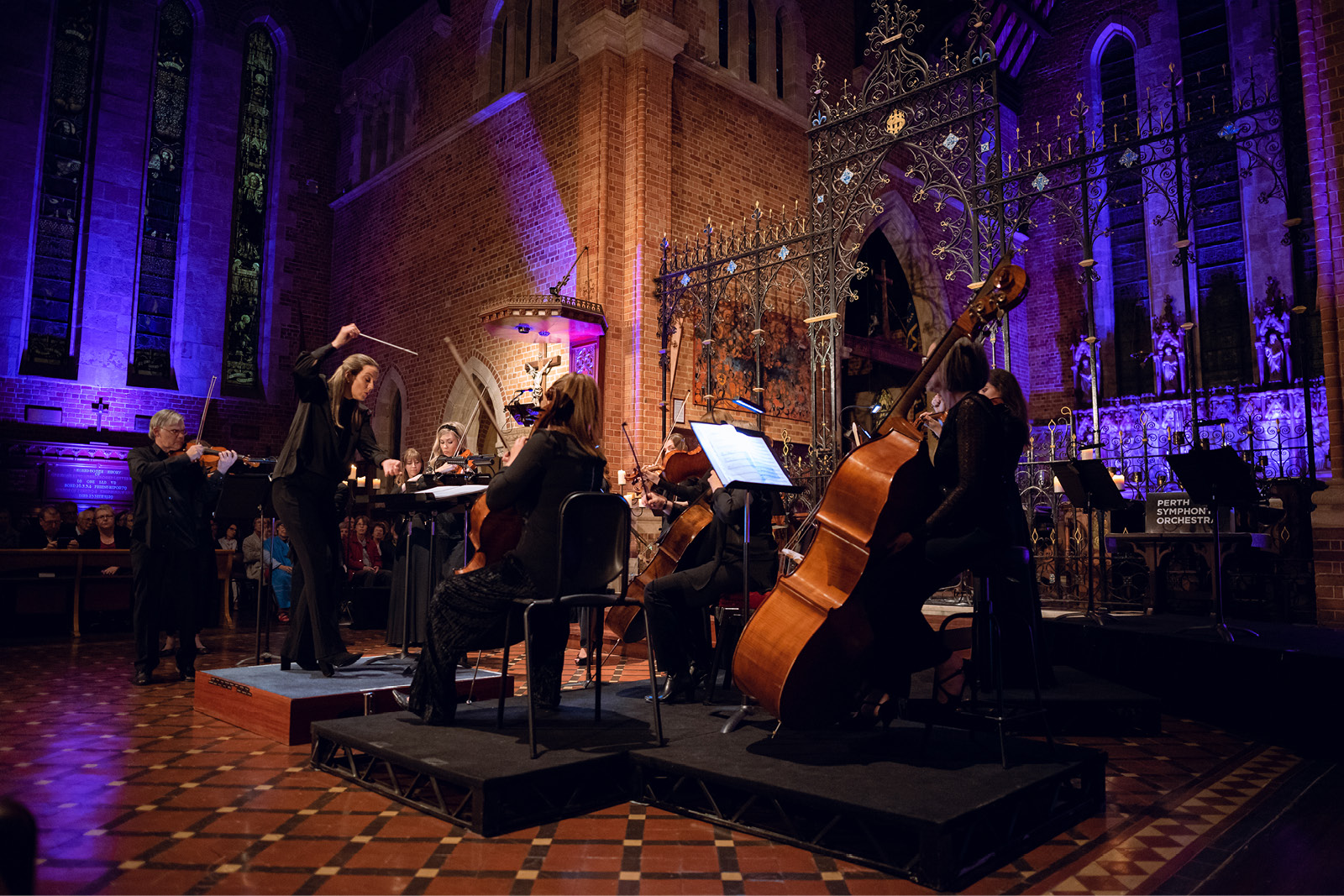The Perth Symphony Orchestra’s latest project was a full-length ode to the music and legacy of Mozart, performed in a candlelit St George’s Cathedral, and appropriately titled Mozart by Candlelight. Programming the Mozart-inspired works of living composers between the masterworks of Mozart himself, PSO sought to demonstrate that the spirit of Mozart is alive and well today.
 Jessica Gethin conducting the Perth Symphony Orchestra. Photo courtesy of Perth Symphony Orchestra
Jessica Gethin conducting the Perth Symphony Orchestra. Photo courtesy of Perth Symphony Orchestra
Setting the tone for the evening with Eine Kleine Nachtmusik, the front desks of the PSO string section captured the instantly recognisable spirit and style of Mozart from the first chord. The force of the sound – and thus, some of the dynamic contrasts – was initially swallowed up by the sheer size of St George’s Cathedral. But as the middle and lower voices of the ensemble came into their own by the fourth movement (or perhaps our ears had acclimatised to the sound environment), the subtle changes in tone colour and mood became more apparent, and the space of the cathedral was no longer an issue. An ambitious update to such a well-known piece was to have each movement broken up by spoken excerpts from some of Mozart’s letters, a touch potentially poignant had the disembodied voice not been so reminiscent of Tommy Wiseau. Strange, yet refreshing all the same.
Calvin Bowman’s Homage to Mozart saw the PSO string forces reduce even further, leaving each principal player in a quartet configuration. Some finely tuned opening chords blossomed into gorgeous playing from concertmaster Paul Wright, whose warm vibrato lent itself perfectly to the post-Romantic idiom the work of Mozart had been reimagined into. The lush Largo gave way to a vibrant Presto as the quartet navigated instantly recognisable quotations of Mozart amongst a series of irregular, rapidly changing time signatures. The cheeky Mozartian spirit was nicely sustained throughout the movement, while also serving as a foil to the previous work.
And so to foil a foil, Johnathan Dove’s An Airmail Letter from Mozart explored some of the darker elements of the Mozartian musical language, calling on extra strings plus horns and piano in his reimagining of Mozart’s Divertimento K287. The horns and the piano were particularly effective here in conjuring up some interesting colours and moods, though by this point the use of Mozartian quotations – as cleverly integrated as they were – bordered on repetitive. Interestingly, Dove’s composition, just like that of Bowman’s, makes use of irregular and constantly shifting metric patterns. In reimagining Mozart, it appears that there’s a shared consensus amongst composers that young Wolfgang would have enjoyed this rhythmic device, but perhaps not any ventures beyond conventional, functional harmony.
Initially, it seemed that the world premiere of Joe Chindamo’s Fantasie auf Nachtmusik was to follow this pattern. Whilst charming and somewhat intriguing, the opening movements of the work seemed to follow the work of Bowman and Dove in their rhythmic structure (with conductor Jessica Gethin guiding the PSO strings beautifully through the metric patterns) and overall feel. But the work eventually came into its own in a big way, experimenting with extended string techniques for some fantastically glassy, artificial colours, and deliberately subverting the Classical cadential patterns of Mozart’s music by shifting the root note in the basses to sound ‘wrong’ (and yet, oh so right!) The finale of the Fantasie explored new harmonic territory to great effect, and the strings of PSO (mostly) handled the curveballs the score threw at them. PSO had been playing it safe up until this point, and it was excellent to see them test the boundaries of Mozart’s legacy in a musically engaging way.
But of course, to conclude the evening, we have to come back to Mozart himself. The Piano Concerto No 17 in G was an excellent vehicle to showcase soloist James Huntingford, whose remarkable musicianship was apparent in his seamless switching between sensitive accompanist to the orchestra to enchanting soloist who brought much charm and humour to the outer movements. However, it was the inner Andante movement in which Huntingford really shone, shaping the music with his evocative phrasing and gentle lyricism. The PSO strings, well and truly warmed up by this point, were solid supporters of Huntingford’s playing, accommodating his lines with ease and expertly handling the material in the tutti sections. The winds, appearing for the first time in the evening, were less warmed up, and experienced a couple of fumbles and intonation issues in the first movement. This was nearly rectified in the opening solos of the Andante, but the texture partially obscured the wonderful bassoon solos of Joanne Littley; the intonation and phrasing of which could have aided the rest of the section. Nevertheless, the performance was met with enthusiastic approval, and I’m confident much of the audience went home that night with a collection of Mozart-inspired earworms burrowing into their minds.











Comments
Log in to join the conversation.